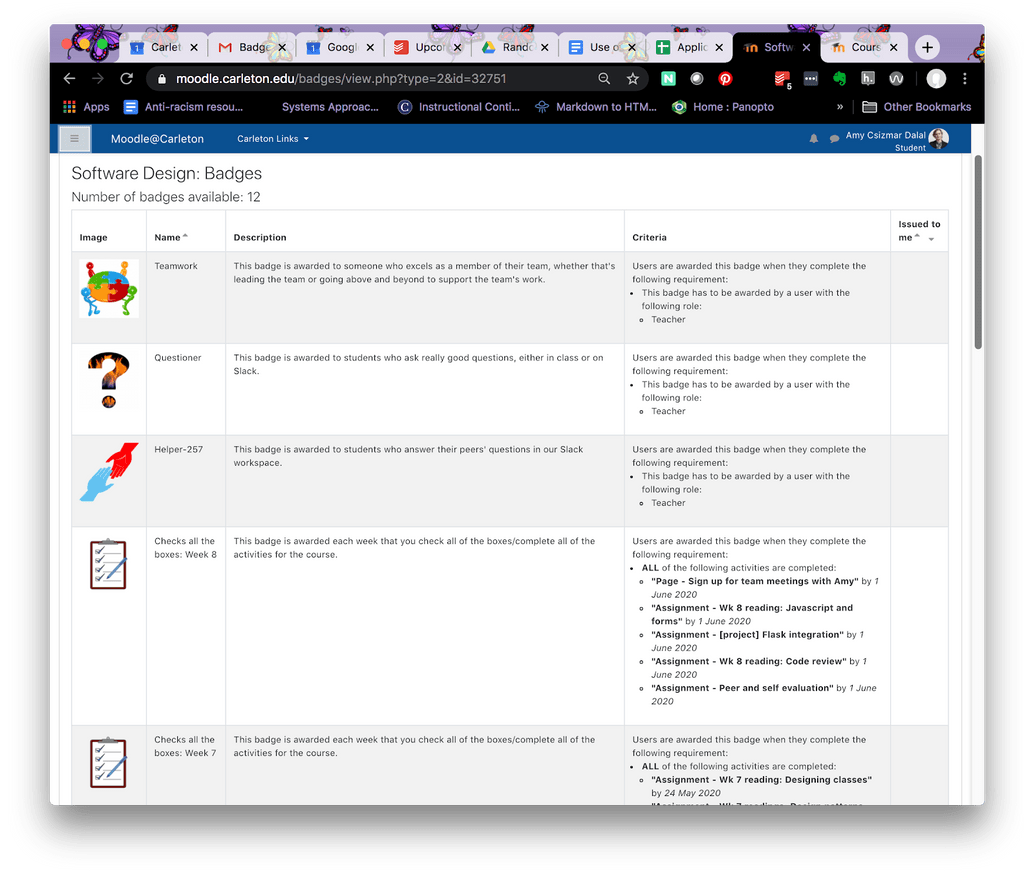This is the second post on how faculty are using badges in their online courses this term. (See Part 1.) Amy Csizmar Dalal (Computer Science) generously walks me through why she decided to start using badges midway through the term, what course activities earn badges, and her perspective on how things went.
Why did you decide to use badges?
Like many of my colleagues, I struggled to get students to meaningfully participate with each other outside of class and outside of their project teams. I use Slack for class discussions, reading reflections, announcements, and such. Even though I encouraged students to answer each others’ questions and reply to their comments, the students largely stuck to posting their own questions and responding just to me. (Note that this is exactly what happens in a non-virtual term, so in retrospect I don’t know why I expected engagement to be magically different this time around.)
At the same time, around the middle of the term, I noticed the energy levels dropping in our weekly (optional) synchronous class meetings. While attendance was certainly high at these, engagement was certainly not. I’d heard of other colleagues trying badges and decided to try them out. What did I have to lose at this point?
How did you decide what activities would earn badges?
I started with the behaviors I wanted to reward:
- Showing up consistently
- Responding to classmates and answering their questions
- Posting insightful questions on Slack in response to the readings
- Going above and beyond in terms of teamwork, since most of the course revolves around a team project and team discussions
- Turning in work on time consistently
Then I turned these into badges:
- Showing up consistently = Attendance badge. Manually awarded by me to students who consistently show up to the optional synchronous meetings.
- Responding to classmates = Helper badge. Manually awarded by me to students who provide help on Slack to their classmates.
- Posting insightful questions = Questioner badge. Manually awarded by me when a student posts an especially good question or insight into the readings, or draws a connection to something outside fo the course.
- Going above and beyond in teamwork = Teamwork badge. Manually awarded by me, to students identified by their peers as especially effective teammates (based on responses to peer/self evaluations at the end of Week 8).
- Turning work in on time consistently = Checks All The Boxes badge. These are automatically awarded once a student checks off all the activities for a given week as complete, by a given date. There is a separate badge for each week in the course, so students can earn a version of this badge each week. (The other badges are awarded once and do not expire.)
Did badges require a lot of extra work on your part?
It took me about 90 minutes to figure out what I was doing and set everything up.
I go in about once a week to manually award badges, to check who earned last week’s “Checks All The Boxes” badge, and to set up the next week’s “Checks All The Boxes” badge. The whole thing takes about 5 minutes.
How did you create badges?
I used images I found on Google image search, that are licensed as “free to use and share”.

Did the badges work as you hoped? Would you use them again?
I did not advertise the badges to students, so I don’t know how many noticed them. While there was not a noticeable uptick on student engagement with each other on Slack, I did notice that a few of those who received badges (manually or otherwise) increased their posts on Slack slightly, and/or continued to show up at synchronous sessions “just to listen” even if they didn’t have questions.
That said, I would definitely do this again, even in a face-to-face class. Because I felt better — it was a small and relatively easy way to reward students for doing the things we want students to do. The startup costs were not huge. And I even had fun putting the badges together!
What advice do you have for colleagues who are considering using badges?
- Start with badges early in the term, before engagement lags.
- Badges are best when part of a package of acknowledging student contributions. Badges signal to individual students that you see them and appreciate their contributions, but publicly calling attention to their contributions signals to other students what behaviors you reward. The latter can be as simple as “I plan on responding to the points raised by Selma, Amir, and Jody in our class meeting today”.
- It took me a bit of muddling around to figure out the badge-making interface, but once I did it was pretty straightforward. [This was] definitely time well spent.
Add a comment